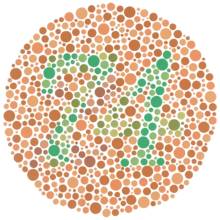| Color blindness | |
|---|---|
| Other names | Colour blindness, color deficiency, impaired color vision[1] |
 | |
| Example of an Ishihara color test plate. With properly configured computer displays, people with normal vision should see the number "74". Many people who are color blind see it as "21", and those with total color blindness may not see any numbers. | |
| Specialty | Ophthalmology |
| Symptoms | Decreased ability to see colors[2] |
| Duration | Long term[2] |
| Causes | Genetic (inherited usually X-linked)[2] |
| Diagnostic method | Ishihara color test[2] |
| Treatment | Adjustments to teaching methods, mobile apps[1][2] |
| Frequency | Red–green: 8% males, 0.5% females (Northern European descent)[2] |
Color blindness, also known as color vision deficiency, is the decreased ability to see color or differences in color.[2] Simple tasks such as selecting ripe fruit, choosing clothing, and reading traffic lights can be more challenging.[2] Color blindness may also make some educational activities more difficult.[2] However, problems are generally minor, and most people find that they can adapt.[2] People with total color blindness (achromatopsia) may also have decreased visual acuity and be uncomfortable in bright environments.[2]
The most common cause of color blindness is an inherited problem in the development of one or more of the three sets of color-sensing cones in the eye.[2] Males are more likely to be color blind than females, as the genes responsible for the most common forms of color blindness are on the X chromosome.[2] As females have two X chromosomes, a defect in one is typically compensated for by the other, and she is a carrier carriers.[2] Males only have one X chromosome and therefore express the genetic disorder when possessing the gene.[2] Color blindness can also result from physical or chemical damage to the eye, optic nerve or parts of the brain.[2] Diagnosis is typically with the Ishihara color test; however, a number of other testing methods, including genetic testing, also exist.[2][3]
There is no cure for color blindness.[2] Diagnosis may allow a person's teacher to change their method of teaching to accommodate the decreased ability to recognize colors.[1] Special lenses may help people with red–green color blindness when under bright conditions.[2] There are also mobile apps that can help people identify colors.[2]
Red–green color blindness is the most common form, followed by blue–yellow color blindness and total color blindness.[2] Red–green color blindness affects up to 8% of males and 0.5% of females of Northern European descent.[2][4] The ability to see color also decreases in old age.[2] Being color blind may make people ineligible for certain jobs in certain countries.[1] This may include being a pilot, train driver, crane operator, and working in the armed forces.[1][5] The effect of color blindness on artistic ability, however, is controversial.[1][6] The ability to draw appears to be unchanged, and a number of famous artists are believed to have been color blind.[1][7]
References edit
- ^ a b c d e f g Gordon N (March 1998). "Colour blindness". Public Health. 112 (2): 81–4. doi:10.1038/sj.ph.1900446. PMID 9581449.
- ^ a b c d e f g h i j k l m n o p q r s t u v w "Facts About Color Blindness". NEI. February 2015. Archived from the original on 28 July 2016. Retrieved 29 July 2016.
- ^ Reference, Genetics Home. "Color vision deficiency". Genetics Home Reference. Archived from the original on 2020-01-10. Retrieved 2019-05-06.
- ^ Wong, Bang (2011-06-01). "Points of view: Color blindness". Nature Methods. 8 (6): 441. doi:10.1038/nmeth.1618. ISSN 1548-7105. PMID 21774112. Archived from the original on 2020-07-28. Retrieved 2020-08-07.
- ^ "OSHA does not have requirements for normal color vision. | Occupational Safety and Health Administration". www.osha.gov. Archived from the original on 2019-05-06. Retrieved 2019-05-06.
- ^ Marmor MF, Lanthony P (March 2001). "The dilemma of color deficiency and art". Survey of Ophthalmology. 45 (5): 407–15. doi:10.1016/S0039-6257(00)00192-2. PMID 11274694.
- ^ Marmor MF (February 2016). "Vision, eye disease, and art: 2015 Keeler Lecture". Eye. 30 (2): 287–303. doi:10.1038/eye.2015.197. PMC 4763116. PMID 26563659.